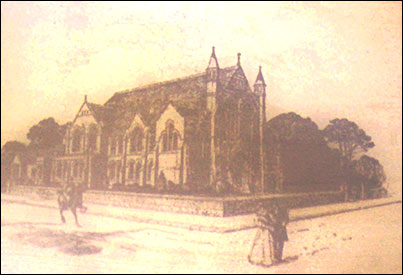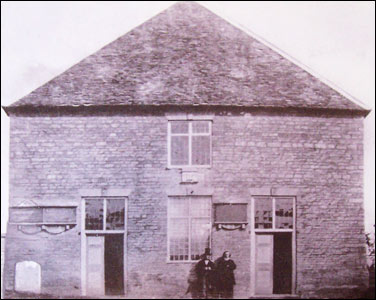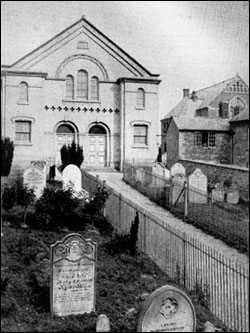|
||||||||||||||||||||||||||||||||||||||||||||||||||||||||||||||||||||||||||||||||||||||||||||||||||||||||
| Rushden Echo, Friday 28th August 1900, transcribed by Gill Hollis |
||||||||||||||||||||||||||||||||||||||||||||||||||||||||||||||||||||||||||||||||||||||||||||||||||||||||
|
Rushden Old Baptist Church
The Building of The New Chapel |
||||||||||||||||||||||||||||||||||||||||||||||||||||||||||||||||||||||||||||||||||||||||||||||||||||||||
|
Laying The Memorial Stones - Splendid Speech by a Nonogenarian
Monday last was an important day in the history of the Rushden Old Baptist Church, the corner-stones of the new chapel being laid amid many manifestations of interest on the part of the townspeople. The Baptist Church is one of the oldest of the Free Churches in the town, having existed for two centuries. It has now a membership of nearly 300, and a Sunday school of nearly 600 scholars. The existing chapel being far too small for the constantly increasing congregations, it was wisely decided to build a larger and more commodious edifice, and a suitable site was obtained in Park-road. Mr. H. H. Dyer, of Northampton, is the architect, and, as will be gathered from the sketch above, he has drawn plans for a very handsome structure. Mr. C. E. Bayes, of Rushden, secured the tender, and the total cost will be about £5,000 or £6,000. Mr. J. F. Knight is the secretary of the Building Committee and Mr. W. B. Sanders the treasurer. Under the title of “The Romance of a Northamptonshire Baptist Church,” an account of The History of The Old Baptist Meeting
In 1708 the church provided A Better Sanctuary, a tenement being converted into a meeting-house. In 1796, the meeting-house was rebuilt on the same site, other property being secured to provide a burial ground, and its appearance at this time may be seen from the accompanying block. It would surely be difficult to surpass it for plainness, with its bare walls and thatched roof. In 1860 schoolrooms were added in the rear of the chapel; while in 1873 a new front was erected, which gave the building a somewhat imposing appearance looked at from its Little-street entrance.The Stone-Laying Ceremony attracted a large company representative of all the churches in the town and including many visitors from the district. The proceedings opened with the singing of a very appropriate stone-laying hymn as follows :-
The Rev. M.E. Parkin (Congregationalist) read the 84th Psalm, after which the Rev W.R. Skerry offered up prayer. An interesting address was then given by the Rev. W.F. Harris (pastor), who said it was A Memorable Day in the history of the people called Baptists. It was no misnomer to speak of their church as the Old Baptist Church, for it had existed over 200 years, and there were many sacred and hallowed memories clustered around that old building which they were presently to leave. Their senior deacon (Mr. S. Knight). who would lay a stone that day, was within seven or eight years of being a century old, and has been a member of that church for 67 years and a deacon for half a century, his father before him having been a deacon for 37 years. Then Mr. John Cave had been in membership with them for 47 years, and Mr. Bayes and Mrs. Bradfield for about 40 years. He could also see before him a good friend who had been a member of the choir for over half a century. So that they had a right to claim antiquity for their church; but while the church was old in years he hoped it was young in energy, enterprise and enthusiasm. (Hear, hear.) They had had many manifestations of this in the way in which the work of chapel building had been taken up, and to-day many friends saw the realization of their hopes, the answer of their prayers, the fulfilment of their dreams that a new Baptist sanctuary would be built in Rushden. Surely the erection of that building would mean something to The Larger Life of Rushden Their Free Churches had exerted a powerful influence for good upon the national life, having been the source and the inspiration of progress, having been the nurseries for all that was best and noblest in the human character. (Hear, hear.) Some of them felt that the strength of the nation and the best defence of the nation were not in the armies and navies – necessary as these were – but in the character of its people. (Hear, hear. ) Their churches were the builders of character. In the coming century that Baptist church would be a witness of faith in the unseen; a witness of their belief in the Trinity, and in the spirituality of the Church – that the Church was a company of redeemed souls, separated from the world, but permeating it like leaven and salt. That building would stand for the spirituality of worship – that worship was an inward thing and must be rendered in spirit and in truth. It would stand for the spirituality of the ordinances and for the spiritual control and the self control of the Church rather than the control of monarch or Parliament. It would stand for The Great Principle of Voluntaryism - that love for Christ should be the motive and the inspiration for Christian work and service. The stones which would be laid that day were not inscribed, but a tablet bearing the names would be erected in the vestibule of the new building. Stones were then laid and contributions laid thereon as follows :-
The Rev. W. F. Harris also laid a stone on behalf of the Sunday school children who had collected £47 In a brief speech Mr. Barrow expressed a hope that the pulpit of that new church would be a place from which emanated light and spirituality. Mr. W. Banks Skinner said that as A Native of Rushden he was pleased to see that fine church which would be an evidence of the prosperity of the town and of the gratitude of Rushden people for benefits received. He hoped that church would be the centre of operations for all that was best in human life. Then came the great event of the afternoon – the laying of a stone by the senior deacon, Mr. Samuel Knight, who is in his 93rd year. Speaking in a marvellously clear voice, Mr. Knight said the work of that day carried him back perhaps 2,500 years when the Jews returned from Babylon. The old men, who had been favoured to see Solomon’s Temple before they went away, wept when they came back and saw the foundation of the Second Temple, because it was so mean and so small compared with Solomon’s Temple; but the young men, who perhaps were born in Babylon and had not seen the First Temple, shouted aloud, and there was a great noise with the old men weeping and the young men shouting. They were highly favoured that day in Rushden. They beheld a better and a bigger sanctuary, so the old men must shout together with the young men. (Applause). He was thankful to be permitted to be amongst them that day. Though the Second Temple was small, yet there was more glory attached to it, because Christ came to that Second Temple; and, though Christ’s bodily presence might not enter that church, yet they hoped for His spiritual presence. Mr. Knight proceeded to make effective use of the jeers of Sanballat and Tobiah, who, when Nehemiah was rebuilding the walls of Jerusalem, said “If a fox go up, he shall break down this stone wall.” There was no Sanballat that day. (Laughter and cheers.) He hoped Mr. Bayes would build the chapel so strong that Neither Four-Legged Foxes Nor Two-Legged Foxes would be able to pull it down. (Laughter and applause.) The effect of Mr. Knight’s speech cannot be described. Held up by friendly hands, and in the full possession of all his mental and apparently most of his physical capacities, he spoke with such force and power that notwithstanding the fact that he is within seven years of being a centenarian, the whole of the congregation could hear him with ease. Others who had stones also gave brief addresses. Tea was provided in the schoolroom about 300 being present. The ladies presiding at the trays, were Mesdames Harris, Amos Cave, Fred Cave, Arthur Cave, J. F. Knight, King, Chas. Green, C. E. Bayes, Knight, sen., Nunley, F. Bayes, F. Newman, Wilkins, Collins, Leeding, Clayton, J. T. Colson, J. Farey, Andrew Corby, William Green, William Sanders, Ballard, W. S. Hartwell, John Sargent, John Wilmott, and S. Chettle, and Misses Lowick, Colson, Putnam, and Foskett (2). In the evening a Public Meeting was held in the chapel, Ald. Cleaver presiding. The Revs. F. T. Smythe and A. Morgan (Northampton) and W. Fidler (Towcester), who were announced to be present were unable to attend. The Chairman said that the Baptist Association of Northamptonshire looked to Rushden to have a still greater career in the future than in the past. He was pleased to know that the young people were taking such a great interest in this forward movement in Rushden. (Hear, hear.) There was a great deal of work in the world waiting to be done. Even in Rushden their surroundings were not perfect, and they must work to secure a better condition of things. He congratulated the Baptists upon having made the present effort, and hoped they would be able to open the chapel free of debt, as was the case with the Metropolitan Tabernacle. (Hear, hear.) After an anthem, “In the beginning was the Word,” by the choir, Mr. W.Banks Skinner gave a cherry address, and said it augured well for the success of The Old Top Meeting that there were so many young people associated with that church. He urged the people to aim high and to hope much. With the enthusiastic work of the young people the future prosperity of the church was assured. It seamed to him that the instinct of temple building had existed from the earliest ages, and the gathering they had held that afternoon was one of the most important in the history of the Baptist cause in Rushden. He thought Christians should not be behind the Pagans in making their churches beautiful. Extreme ugliness and plainness characterised the places of worship in England in one period, and they must not blame the people of those days, for the plainness was a protest against the Roman Catholic idolatries, leading up to that glorious reformation, of which they were all so proud. (Hear, hear.) After alluding to the work of John Bunyan and his association with the Rushden church, Mr. Skinner referred to the pastors of days gone by including Whittemore, the founder of the Christian World, the late Mr. Bradfield, and others. He attributed a great deal of the success which had attended Rushden to the temperance work of Mr. Bradfield. (Hear, hear.) Rushden Had Gone On Growing and they were not now content with small things. Their grand old parish church was one of the finest specimens of the Perpendicular style of architecture, and they had now also two fine Wesleyan chapels. He was pleased that the Baptists were going to put up such a handsome building, for a beautiful church was not inconsistent with Nonconformity. (Hear, hear.) He believed in an ornate service. They wanted good singing – and in Rushden they got it. (Hear, hear.) When he heard their choir he was proud he was a Rushden man. (Hear, hear.) After lamenting the prevalence of drunkenness in the country, Mr. Skinner touched upon the question of Ritualism and said that his complaint against the ritualistic section of the Church of England was that they so obscured the truth of Christ as to put Him in the background. They might call The Ritualistic Section of the Church a religious organization if they liked, but it was certainly not the Church of Christ. In Rushden they had been very fortunate in their clergyman, from the time of Canon Barker to the present day. (Hear, hear.) The Rev. W.R. Skerry, of London, said he was glad that at the end of the glorious 19th century the friends at Rushden were building that church. He believed the Spirit of Christ was laying hold of nearly all the churches and moving them to greater endeavours. He was thankful that in Rushden they had such wise and bold leaders, and he urged the Church to follow their leaders, for the undertaking they had in hand was a noble one. Rushden, he believed, would in the next fifty years be the better for the new Baptist Church. They were doing great things that day – greater than they believed. He was glad they had heard the call, “Arise and build,” and he rejoiced that they had responded to the call. (Hear, hear.) The Rev. W. F. Harris then made a Financial Statement They estimated the expenditure at £5,750, as follows :-
On the other hand, Mr. Harris said, they had the following sums :-
In round figures therefore, there was still about £2,500 to be raised before the chapel can be opened free of debt. He (Mr. Harris) hoped they would soon get this chapel free of debt and then build another one at the other end of Rushden. Their new chapel would seat 800 adults or a mixed congregation of 1000 adults and children – double the seating accommodation of the present chapel. The Rev. C. F. Groom (Wesleyan) also gave an address.
|
||||||||||||||||||||||||||||||||||||||||||||||||||||||||||||||||||||||||||||||||||||||||||||||||||||||||


